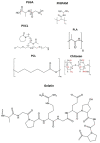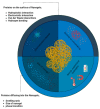Polymeric Nanoparticles and Nanogels: How Do They Interact with Proteins?
- PMID: 37623087
- PMCID: PMC10453451
- DOI: 10.3390/gels9080632
Polymeric Nanoparticles and Nanogels: How Do They Interact with Proteins?
Abstract
Polymeric nanomaterials, nanogels, and solid nanoparticles can be fabricated using single or double emulsion methods. These materials hold great promise for various biomedical applications due to their biocompatibility, biodegradability, and their ability to control interactions with body fluids and cells. Despite the increasing use of nanoparticles in biomedicine and the plethora of publications on the topic, the biological behavior and efficacy of polymeric nanoparticles (PNPs) have not been as extensively studied as those of other nanoparticles. The gap between the potential of PNPs and their applications can mainly be attributed to the incomplete understanding of their biological identity. Under physiological conditions, such as specific temperatures and adequate protein concentrations, PNPs become coated with a "protein corona" (PC), rendering them potent tools for proteomics studies. In this review, we initially investigate the synthesis routes and chemical composition of conventional PNPs to better comprehend how they interact with proteins. Subsequently, we comprehensively explore the effects of material and biological parameters on the interactions between nanoparticles and proteins, encompassing reactions such as hydrophobic bonding and electrostatic interactions. Moreover, we delve into recent advances in PNP-based models that can be applied to nanoproteomics, discussing the new opportunities they offer for the clinical translation of nanoparticles and early prediction of diseases. By addressing these essential aspects, we aim to shed light on the potential of polymeric nanoparticles for biomedical applications and foster further research in this critical area.
Keywords: disease diagnosis; nanogels; nanoproteomics; polymeric nanoparticles; protein corona.
Conflict of interest statement
The authors declare that they have no conflict of interest.
Figures










References
-
- Cedervall T., Lynch I., Lindman S., Berggård T., Thulin E., Nilsson H., Dawson K.A., Linse S. Understanding the nanoparticle–protein corona using methods to quantify exchange rates and affinities of proteins for nanoparticles. Proc. Natl. Acad. Sci. USA. 2007;104:2050–2055. doi: 10.1073/pnas.0608582104. - DOI - PMC - PubMed
-
- Chen X., Chen J., Huang N. The structure, formation, and effect of plasma protein layer on the blood contact materials: A review. Biosurf. Biotribol. 2022;8:1–14. doi: 10.1049/bsb2.12029. - DOI
Publication types
LinkOut - more resources
Full Text Sources
Miscellaneous

